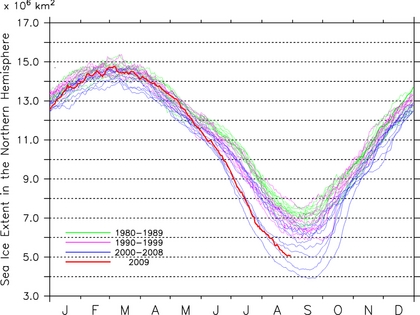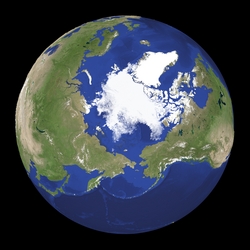2009.09.01
GIC Weekly Report for the Arctic Region Vol.5
Decline continues, but both routes are still closed
Topic of the Week
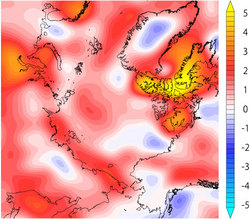
Figure 1. Anomaly of surface air temperature (difference from the average of past years) in 2009 August over the Arctic region (click to enlarge)
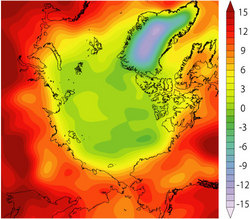
Figure 2. Monthly average of surface air temperature in 2009 August over the Arctic region (click to enlarge)
Trends have continued this week, with sea ice declining in all regions, although there is still the presence of ice within the Taimyr peninsula and the Canadian Arctic West that has resulted in both passages remaining closed to vessels.
Temperature anomaly analysis (FIGURE 1) throughout August has shown that within the Western passage, the Canadian Arctic region had higher than average temperatures of 2-5oC and within the Eastern passage, the Taimyr peninsula had temperatures of 0-2oC. These higher than average temperatures were seen throughout the Arctic region, and were a result of high pressure systems residing over both passages, this resulted in clear skies and higher temperatures. In the Western passage warm air masses from North America were brought up to the Canadian Arctic, adding to the already high temperatures in the region. Mean August temperatures (FIGURE 2) within the passages range between 5-9oC, although lower temperatures can be seen on the Eastern passage at higher latitudinal, coastal areas such as the Novaya Zemlya island which has been influenced by colder air from higher latitudes.
Ice movement throughout August has been dictated by a low pressure system, situated over the East Siberian Sea, and a high pressure system over Greenland. The low pressure system has moved slowly east through the month influencing the movement of ice to a more westerly direction. At the start of the month a high pressure system caused ice to accumulate in the Beaufort Sea, but this soon deteriorated leaving the predominant influence of the low pressure system to move sea ice towards the Eastern passage, this accumulated at the Taimyr peninsula.
Sea Ice Extent
The sea ice extent for the Northern Hemisphere is recorded to be the third lowest ever recorded within historical records. The North Western/Eastern passages are also recorded to be the third lowest sea ice extent in recorded history. The above indicates a continued decline in sea ice throughout the Arctic region. Figure 3. shows the extent of ice over the Arctic region.
Sea Ice Conditions along Polar Routes
| NW Passage |
| Gulf of St.Lawrence |
Grand Banks |
Labrador Sea |
Davis Strait |
Baffin Bay |
Canadian Arctic E |
Canadian Arctic W |
Beaufort region |
Chukchi | Bering West |
| IF | IF | IF | IF | IF | IF | IF | IF | IF | |
| Greenland Sea SW |
Foxe Basin |
||||||||
| IF |
| NE Passage |
| Bering West |
Chukchi | East Siberian |
Laptev | Kara Sea N |
Barents Sea NE |
Barents Sea S |
Barents Sea NW |
| IF | IF | IF | IF | IF | IF | ||
| Kara Sea S |
|||||||
| IF |
| Ice Concentration | Passage situation | |
| equal or more than 7 |
ships can not sail without icebreaker | |
| 4-6 | ice-strengthend ships can sail | |
| less than 3 | ice-worthy ships can sail | |
| IF | Ice Free | normal ships can sail |
Table. Sea ice extent for each region in the Arctic, showing the labelled colors to indicate navigable routes around the North Eastern and North Western passages.
Both passages remain closed to vessels for the time being, although melting is still occurring. Within the Canadian Arctic West, thick first year ice continues to block the passage between Somerset and Prince of Wales islands showing little sign of completely disappearing in the near future, although melting is still occurring in this region. Foxe Basin is also continuing to clear of ice with more areas of only 1/10th ice over, although to the north east of the basin there are still areas that have 7-8/10th of ice concentration. Other areas within the Western passage remain open to vessels. Modis imagery shows that the North Eastern passage remains closed with areas within the Laptev Sea and the Kara Sea North showing a small amount of decline in sea ice but not enough to allow vessels to pass through this region.
Model Prediction
Weathernews's I-SEE engine indicates that a low pressure system will reside over the North Eastern passage for the first part of the month causing ice to migrate towards the Taimyr peninsula, this however will not persist, due to another low over the Chukuchi Sea, influencing the ice to move towards the East Siberian Sea, this pattern will continue until the middle of the month. On the Eastern passage there is set to be a decline in ice around the Taimyr peninsula, this may result in the opening of the passage around the middle of September.
Within the North Western passage, sea ice will continue to decline within the Canadian Arctic regions. Atmospheric motion throughout the month will cause the migration of ice once again to the Greenland Sea resulting in an accumulation of ice in this area. Other areas such as the Beaufort Sea along the Alaskan coast will expect to receive a slight decrease in sea ice throughout the first part of the month, however the migration of high pressure systems to this area is expected to cause a slight fluctuation in sea ice movement throughout the month.
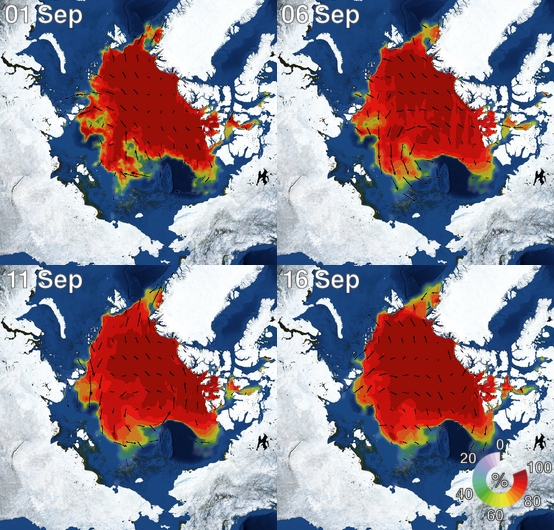
Figure 5. I-SEE engine, model predictions of the arctic sea ice


